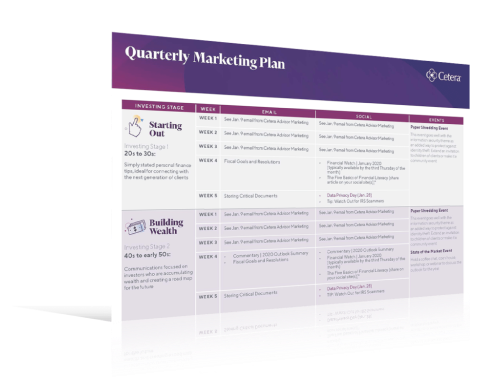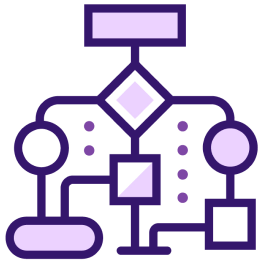5%
increase in client retention can drive a

Use this guide to better understand how to reach new clients and engage with existing clients through a customer relationship management (CRM) tool and segmentation.
Current and prospective clients want to feel like they have a personal relationship with you and your firm. It’s easier to treat them as individuals when you’re just starting out, but as your firm grows, it becomes more difficult to keep up that level of interaction with every client. Don’t just assume that everyone wants the highest quality at the lowest price. People’s needs are different, and so are their relationships with you.
When a client talks to anyone in your firm, they want a seamless experience: their unique history and needs are already known, and the conversation picks up exactly where they last left it. Giving clients this personalized and prepared approach gives them the kind of service they’re looking for and builds greater trust.
Segmenting your clients and prospects into logical and helpful categories is a great way to retain clients and earn new business. It can help target your messaging in a way that makes clients and prospects feel like you were just thinking about them.
increase in client retention can drive a
increase in profit.¹
creating a customer journey, which outlines the way that a person interacts with a firm to reach their desired goals. Getting into the minds of your clients and prospects can be challenging, but doing so can help you close more new business and, more importantly, retain the business you have now.
A journey map is a visual diagram of the steps a person needs to take to get to “success” with your firm. Start with prospects and try to map all the way to them referring business or consolidating assets with your firm. Map out key events like getting the first lead, having initial discussions and opening new accounts. Use sticky notes or an Excel spreadsheet to track all the steps, getting input from your team along the way.
Once you have the process mapped out, add the person’s actions along the journey. What will they do? Who will they talk to? What are they feeling or experiencing at each point?
You can then use your journey map to develop your client experience model and segmentation strategy.

Grouping clients together and segmenting your book of business allows you to focus on the actions you want to take and, at the same time, helps the client or prospect feel like you are centrally focused on them and their specific needs.
How Segmentation Can Help
When asked the most effective tactics for improving their email results, 39% of marketers who segmented their email lists experienced higher open rates, 28% experienced lower unsubscribe rates, and 24% experienced better deliverability and greater revenue.²
There are plenty of ways to divide your contact list to fit your business goals. Some basic segments could be:
When you’re ready to start segmenting your contact list and sending regular emails to your clients, there are a few best practices to keep in mind.

To effectively launch a segmentation strategy, you’ll need a customer relationship management (CRM) tool where you can keep track of client and prospect information.
When you’re communicating with clients across multiple channels (website, social media and email), keeping track of what you’re saying to your clients (and more importantly, what they’re saying to you) helps them feel known by you. A CRM tool is the one place where you and anyone in your firm can find a client’s contact information, understand where they are in the sales process, or what they’ve said are their current needs.
Download our simple CRM guide with three levels of acumen laid out so you can take a step-by step-approach to growth using a CRM and segmentation.
Download The Guide
As you become more familiar with client journeys, segmentation and CRM tools, creating emails is an effective way to reach your target audience with a specific message.
Core Email Communication Types
Not every email is going to resonate with every contact. Some people might appreciate and react to different types of emails, which is why it’s essential that you create, use and send different types of emails for different segments of your contact list. A few email options are:
Simple Email Strategy
Setting a Custom Email Strategy
Every contact with your clients is either positive, negative or neutral. By setting a strategy for your emails and watching results, you can determine if you are being effective.Writing custom emails can be effective because they are usually centered around a client or group of clients. Writing about market changes, community events or other timely content conveys a strong message that your firm is working toward a client’s goals.
Defining Success
Knowing your results by each type will help you determine if your emails are helping or hurting your business goals. Below are a few tips for identifying success:
The Cetera Advisor Marketing team compiles a step-by-step quarterly marketing guide. Set up a time to walk through the quarterly plan with your Growth Officer.

When you’re ready to go beyond sending regular emails to current and prospective clients, you can start to create lead nurturing workflows.
The source of a lead and their familiarity with your firm determines how difficult it will be to convert them into a client engagement or meeting. The number of contacts needed to convert them ranges from three to fifteen.
A prospective client that makes contact through a referral, website visit or other interaction need to be nurtured along the prospect portion of the journey map you created. Adding them into a specific lead workflow designed to nurture them over time can increase their odds of becoming a client. These specific email messages could answer questions you have heard others ask, provide information about your services or profile your team and certifications. Automated email workflows allow you to work many leads at the same time and maintain a personalized feel.

Staying compliant is vital to protect you and your company’s reputations. Take care to avoid language in your emails that sounds promissory or misleading. Use clear, accessible language in every email. These quick steps can help you establish a system of checks within your firm.

Success using a CRM tool and having personalized contact through segmentations is about sending the right message to the right people, at the right time. By using a CRM tool, your team can have a better idea of where each client is in their customer journey and what messaging they should receive to keep them engaged with your firm. MarketingCentral, Cetera’s digital marketing platform, can help you support your email marketing efforts and make segmentation easier.
Use the stages below to assess where you are today and find new opportunities for growth.
Success at the first level is all about making sure you can communicate with your potential and current clients. Your company should have email addresses for people you are in regular contact with or who are in the sales process. All contact information should be saved in a CRM tool with other important details that your team might need to have seamless and valuable conversations with any contact. Any information stored in the CRM should be updated as necessary.
Success at the second level is when you’re beginning to divide your contact list into smaller and more customized groups. Carefully consider how you divide up the list so each contact gets messaging they will find valuable, which can build greater trust in you and your company. MarketingCentral’s email automations give you a variety of topics and messages you can apply to your specific segments.
The third level is all about optimizing the segmentation and emails you send. You’re creating strategies for custom content that’s worthwhile and builds trust with your clients. This can include lead nurturing workflows to ensure that your contacts are getting the right messaging based on their previous interactions with emails you’ve sent. You measure your success and improve your messaging using the data provided in your CRM tool.
Build a strategy for growth with MarketingCentral, a powerful suite of tools built exclusively for you by the Cetera Marketing team. MarketingCentral is a comprehensive multi-channel platform with pre-approved email templates, social media content, downloadable event kits, presentations and so much more that you can fully customize to meet your business and client needs. Take the guesswork out of marketing and focus on growing your business.

Get up and running with this step-by-step guide to MarketingCentral.

Register for an interactive webinar to learn more about the MarketingCentral tools and get assistance with any questions.

Put together a solid client and prospect outreach strategy designed to get results with the help of this straightforward guide.

Explore opportunities to automate marketing communications across email, social and print.

Drive leads and increase prospect conversion rate with these Client Prospecting and Conversion Guides.

Leverage MarketingCentral and these tips to plan, manage and promote your next client or prospect event.

Plan the next year of marketing content and strategy with this calendar template.

MarketingCentral is an approved record retention tool.

Use these tips to personalize a profile if you are using MarketingCentral as an ensemble team or program.

'Cetera Financial Group' refers to the network of independent retail firms encompassing, among others, Cetera Advisors LLC, Cetera Advisor Networks LLC, Cetera Investment Services LLC (marketed as Cetera Financial Institutions or Cetera Investors), Cetera Financial Specialists LLC, and First Allied Securities, Inc. All firms are members FINRA/SIPC. Located at 200 N. Pacific Coast Highway, Suite 1200, El Segundo, CA 90245-5670.
Individuals affiliated with Cetera firms are either Registered Representatives who offer only brokerage services and receive transaction-based compensation (commissions), Investment Adviser Representatives who offer only investment advisory services and receive fees based on assets, or both Registered Representatives and Investment Adviser Representatives, who can offer both types of services.
Learn more at https://fmgsuite.com/marketingcentral/experience/cetera-resources/
1 https://www.fundera.com/resources/brand-loyalty-statistics
2 https://blog.hubspot.com/service/customer-retention
For broker-dealer use only. Not for use with the public.